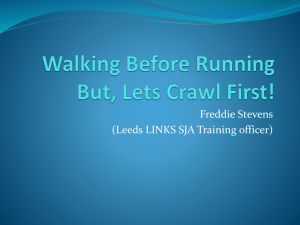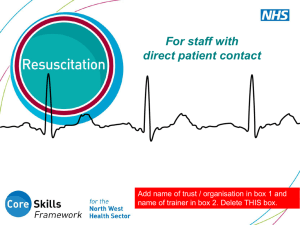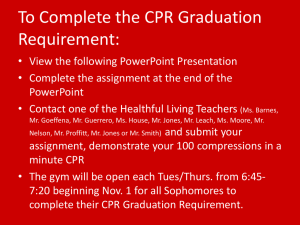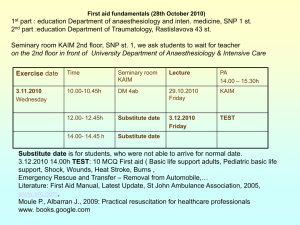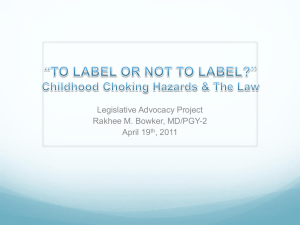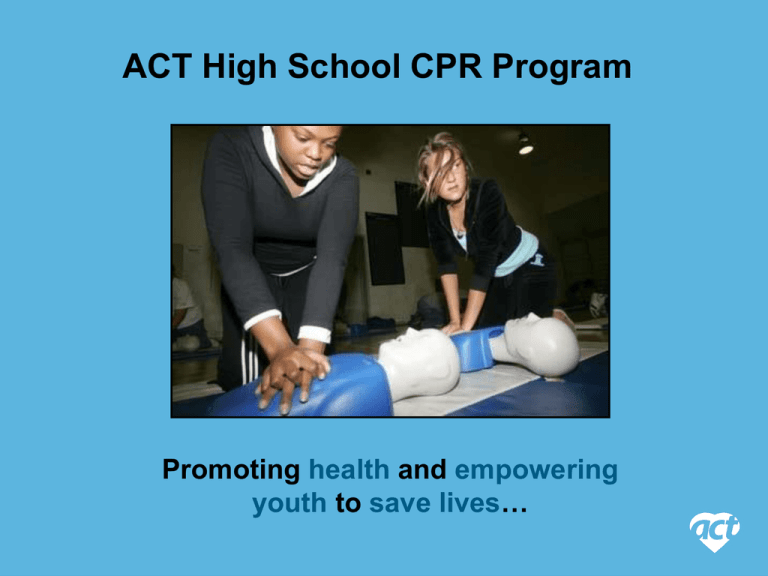
ACT High School CPR Program
Promoting health and empowering
youth to save lives…
What is the ACT Foundation?
ACT…
• Fundraises for mannequins for schools.
• Brings CPR to all schools.
• Is partnered nationally with health partners who
support ACT’s Canada-wide goal for CPR in
schools:
AstraZeneca Canada
Pfizer Canada
Sanofi
Visit ACT! www.actfoundation.ca
Why Do I Need To Learn CPR?
The first link in the
Chain of Survival*
begins with YOU!
* © Reproduced with the permission of the Heart and Stroke Foundation of Canada, 2009.
The Chain of Survival™ is a trade-mark of the Heart and Stroke Foundation of Canada.
See page 3, Student Manual
To read these rescue stories visit:
www.actfoundation.ca
What you’re going to learn…
The 4 R’s …
RISK
RECOGNIZE
REACT
RESUSCITATE
See page 3, Student Manual
But first…
The Heart and When it Breaks
What is a Heart Attack?
Heart
Lungs
Spine
See page 4, Student Manual
The Heart and When it Breaks
What is Cardiac Arrest?
What is CPR?
What is Defibrillation?
See pages 4-5, Student Manual
…
And
What is a Stroke?
See page 5, Student Manual
And now, the 4 Rs…
RISK FACTORS
RISK FACTORS
Smoking
• Leading cause of heart disease in Canada
• Causes lung cancer
• Second-hand air pollution
• Stinky breath
Copyright © Province of British Columbia. All rights reserved.
Reprinted with permission of the Province of British Columbia.
www.ipp.gov.bc.ca
See page 6, Student Manual
RISK FACTORS
Anatomy of a Cigarette
Image courtesy of Thompson Educational Publishing, Inc.
RISK FACTORS
High Blood Cholesterol
• Too much cholesterol can cause
heart disease or stroke
• Means lots of fat in the blood
• Some fat is produced by the body;
other fat comes from food
• What you can do: Eat vegetables, fruits & grain
products; reduce fat in diet; exercise
See page 6, Student Manual
RISK FACTORS
High Blood Pressure
• Can damage your heart and blood vessels
• Increases chances of a heart attack or stroke
• Heart has to work harder
• Some causes: hereditary,
diet, stress
• Get it checked regularly
See page 6, Student Manual
Blood pressure cuff
RISK FACTORS
Diabetes
• Affects the level of sugar and fat in your blood
• Eat properly, follow doctor’s instructions
See page 6, Student Manual
RISK FACTORS
Obesity and Lack of Exercise
• Obesity: Heart has to pump harder all the
time to move blood around
• Exercise: Your heart is a muscle - it works
better if you keep fit & active
See page 6-7, Student Manual
RISK FACTORS
Stress
• Affects the body in very
physical ways
• Stress over a long period of
time can cause body to
break down
• Heart problems may result
See page 7, Student Manual
RISK FACTORS
Summary
Smoking
High Blood Cholesterol
High Blood Pressure
Diabetes
Obesity / Lack of Exercise
Stress
See page 6-7, Student Manual
The 4 Rs…
RISK FACTORS
RECOGNIZE
RECOGNIZE
Signals of a Heart Attack – “5 Ps”
Pain
Pale skin
Puffing
Pooped
Puking
See page 8, Student Manual
RECOGNIZE
Signals of a Stroke
•
Sudden paralysis of the face, arm or leg
•
Sudden speech problems
•
Weakness, numbness,
or tingling in the face, arm or leg
•
Sudden headache or dizziness
See page 8, Student Manual
The 4 Rs…
RISK FACTORS
RECOGNIZE
REACT
REACT
Hazards and Holler!!!
CALL 9-1-1
“PLT”
Position
Loosen clothing
Talk, reassure
See page 9, Student Manual
REACT
Be Visible with Information
• Medications
• Allergies
Flash ‘em!
See page 9, Student Manual
The 4 Rs…
RISK FACTORS
RECOGNIZE
REACT
RESUSCITATE
RESUSCITATE
As simple as CAB-D!
Compressions
Airway
Breathing
Defibrillation
See page 10, Student Manual
RESUSCITATE
One Rescuer CPR – Adult
Step 1.
Check for hazards
Step 2.
Assess responsiveness and check
for breathing
Step 3.
Call 9-1-1 & retrieve defibrillator ASAP
See page 11, Student Manual
RESUSCITATE
One Rescuer CPR – Adult
Step 4.
Landmark for chest compressions
Step 5.
Give 30 compressions
See page 11, Student Manual
RESUSCITATE
One Rescuer CPR – Adult
Step 6.
Open the airway
See page 12, Student Manual
RESUSCITATE
One Rescuer CPR – Adult
Step 7.
Give 2 breaths if the person is
not breathing normally
See page 12, Student Manual
RESUSCITATE
Remember:
30 and 2
30 and 2
30 and 2
is what you do.
Rock ‘em till someone can
SHOCK ‘EM…!
See page 12, Student Manual
RESUSCITATE
Choking – Adult Conscious
Step 1.
Assess the airway blockage
Step 2.
Holler for help
See page 13, Student Manual
RESUSCITATE
Choking – Adult Conscious
Step 3.
Give abdominal thrusts
Step 4.
Repeat abdominal thrusts
See page 13, Student Manual
RESUSCITATE
Choking – If the Choking Person
Becomes Unconscious
Step 1.
Call 9-1-1
Step 2.
Landmark and give 30 chest
compressions
See page 14, Student Manual
RESUSCITATE
Choking – If the Choking Person
Becomes Unconscious
Step 3.
Open the mouth and look for the
obstruction
Step 4.
Open the airway
See page 14, Student Manual
RESUSCITATE
Choking – If the Choking Person
Becomes Unconscious
Step 5.
Try to give a breath
Step 6.
Repeat sequence of chest
compressions
See page 14, Student Manual
RESUSCITATE
Choking – Adult Found Unconscious
Step 1.
Check for hazards
Step 2.
Assess responsiveness and check
for breathing
Step 3.
Call 9-1-1 and get a defibrillator
ASAP
See page 14-15 Student Manual
RESUSCITATE
Choking – Adult Found Unconscious
Step 4.
Landmark and give 30 chest
compressions
Step 5.
Open the mouth and look for the
obstruction
See page 15, Student Manual
RESUSCITATE
Choking – Adult Found Unconscious
Step 6.
Open the airway
Step 7.
Try to give a breath
See page 16, Student Manual
RESUSCITATE
Choking – Adult Found Unconscious
Step 8.
Repeat sequence of
chest compressions
Recovery Position:
See page 15, Student Manual
ACT AWARDS PROGRAM
RESCUES …
Rescued someone?
Know someone who has?
TELL US!
1-800-465-9111 ● act@actfoundation.ca
www.actfoundation.ca
CLOSING NOTES…
More than 1.8 million youth across Canada
have been trained in CPR through the
ACT High School CPR Program.
You are part of something big – VERY big!
1,800,000 trained!



